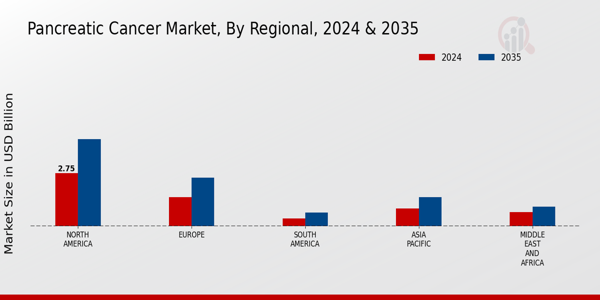Rising Incidence Rates
The increasing incidence rates of pancreatic cancer are a primary driver for the Pancreatic Cancer Market. According to recent statistics, pancreatic cancer is projected to become the second leading cause of cancer-related deaths by 2030. This alarming trend is attributed to various factors, including lifestyle changes and an aging population. As the number of diagnosed cases rises, the demand for effective treatment options and diagnostic tools intensifies. This surge in incidence not only highlights the urgent need for innovative therapies but also propels investment in research and development within the Pancreatic Cancer Market. Consequently, pharmaceutical companies are likely to focus on developing novel drugs and therapies to address this growing health crisis.
Advancements in Treatment Modalities
The Pancreatic Cancer Market is witnessing significant advancements in treatment modalities, which are reshaping patient outcomes. Recent developments in immunotherapy and targeted therapies have shown promise in improving survival rates for patients with pancreatic cancer. For instance, the introduction of checkpoint inhibitors and personalized medicine approaches has opened new avenues for treatment. These innovations are not only enhancing the efficacy of existing therapies but also expanding the treatment landscape for pancreatic cancer. As a result, healthcare providers are increasingly adopting these advanced modalities, leading to a shift in treatment paradigms. This evolution in treatment options is expected to drive growth in the Pancreatic Cancer Market, as patients seek more effective and tailored therapies.
Investment in Research and Development
Investment in research and development is a crucial driver for the Pancreatic Cancer Market. Pharmaceutical companies and research institutions are allocating substantial resources to explore novel therapeutic approaches and improve existing treatments. This focus on R&D is essential, given the historically poor prognosis associated with pancreatic cancer. Recent funding initiatives and collaborations between public and private sectors are fostering innovation in drug development and clinical trials. As a result, the Pancreatic Cancer Market is expected to benefit from the introduction of new therapies and improved treatment protocols, ultimately enhancing patient care and survival rates.
Growing Awareness and Screening Initiatives
Increased awareness about pancreatic cancer and the importance of early detection is significantly influencing the Pancreatic Cancer Market. Public health campaigns and educational initiatives are encouraging individuals to recognize symptoms and seek medical advice promptly. This heightened awareness is likely to lead to earlier diagnoses, which can improve treatment outcomes. Furthermore, the implementation of screening programs for high-risk populations is gaining traction, potentially increasing the number of diagnosed cases. As more individuals are screened and diagnosed at earlier stages, the demand for diagnostic tools and treatment options will likely surge, thereby propelling growth in the Pancreatic Cancer Market.
Regulatory Support and Fast-Track Approvals
Regulatory support and fast-track approval processes are playing a pivotal role in shaping the Pancreatic Cancer Market. Regulatory agencies are increasingly recognizing the urgent need for effective treatments for pancreatic cancer, leading to expedited review pathways for promising therapies. This supportive regulatory environment encourages pharmaceutical companies to invest in the development of new drugs, as they can bring innovative treatments to market more quickly. The availability of accelerated approval processes not only enhances the speed of access to new therapies for patients but also stimulates competition within the Pancreatic Cancer Market. Consequently, this dynamic is likely to foster a more robust pipeline of treatment options, ultimately benefiting patients and healthcare providers alike.


















Leave a Comment